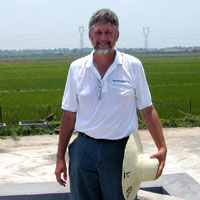Tommy Carter

Bio
Dr. Carter’s research mission is to provide innovative genetic solutions that help improve the nations’ profitability in soy production. As a geneticist and breeder, Dr. Carter’s attack on the problem is to broaden genetic diversity in applied U.S. soybean breeding. In that regard, crop diversity is recognized as the foundation of breeding progress and at the same time perhaps the WEAKEST LINK in U.S. soybean breeding. Of the ~120 soybean breeders in the USA, Dr. Carter is one of only two (and the sole researcher in the southern USA) to devote his/her career to this issue.
Dr. Carter has released 8 cultivars and published more than 80 articles in peer reviewed journals. He also manages approximately 50 acres of field breeding, annually, in support of his diversity research and collaborates extensively with international scientists. Major applications of his work on diversity have been in the areas of drought tolerance and soyfoods.
As a part of his research program on genetic diversity, Dr. Carter summarized the relatedness of all publicly released varieties in North America. Published as a lengthy bulletin, this manual is an aid to breeders in the preservation of diversity in applied breeding programs. The computerized pedigree data base which he developed for this work is the most extensive available in soybean. Dr. Carter also discovered diversity patterns in U.S soybean breeding and estimated the diversity that had been lost through genetic drift. Dr. Carter collaborates with U.S. researchers to relate pedigree-based genetic diversity findings to MOLECULAR MARKER results and to breeding practices in industry.
He also collaborates extensively with breeders from China and Japan (the ancestral home of soybean) to characterize diversity present in Asian breeding programs and to apply that diversity to U.S. breeding.
While exhaustion of genetic diversity is the number one threat to breeding progress, DROUGHT is the number one environmental limitation to soybean yield. Drought tolerance is a rare trait in soybean, and no breeding progress in drought tolerance had been demonstrated. Dr. Carter discovered rare exotic drought tolerant germplasm and used this germplasm to create productive breeding materials with improved drought tolerance. Dr. Carter was the first to identify QTL’s that affect soybean root growth.
The expansion of the Japanese SOYFOODS export market plus the U.S. public’s concern for diet and health have fueled new growth in the U.S. soyfoods industry. When Dr. Carter began work in this area in 1986, no specialty types were available to farmers of the deep south for export to the Japanese. Dr. Carter has developed 5 cultivars for use in this area.
Publications
- Genetic mapping reveals the complex genetic architecture controlling slow canopy wilting in soybean , THEORETICAL AND APPLIED GENETICS (2024)
- Registration of USDA-N6006 soybean germplasm combining high yield, flood tolerance, and elevated oil content , JOURNAL OF PLANT REGISTRATIONS (2024)
- Registration of high-yielding, high-protein soybean germplasm USDA-N7007 derived from wild soybean PI 366122 , JOURNAL OF PLANT REGISTRATIONS (2024)
- Parental choice and seed size impact the uprightness of progeny from interspecific Glycine hybridizations , CROP SCIENCE (2023)
- Registration of USDA-N7006 soybean germplasm with increased tolerance to drought stress and 37.5% pedigree from Asian accessions PI 416937 and PI 407859-2 , JOURNAL OF PLANT REGISTRATIONS (2023)
- Registration of high-yielding maturity group V germplasm USDA-N5001 with high seed and meal protein contents , JOURNAL OF PLANT REGISTRATIONS (2023)
- Identification of Soybean Yield QTL in Irrigated and Rain-Fed Environments , AGRONOMY-BASEL (2021)
- Registration of USDA-N6005 germplasm combining high yield, elevated protein, and 25% pedigree from Japanese cultivar Tamahikari , JOURNAL OF PLANT REGISTRATIONS (2021)
- Inheritance of rhizobitoxine-induced chlorosis in soybean , CROP SCIENCE (2020)
- Leaf gas exchange recovery of soybean from water-deficit stress , Journal of Crop Improvement (2020)